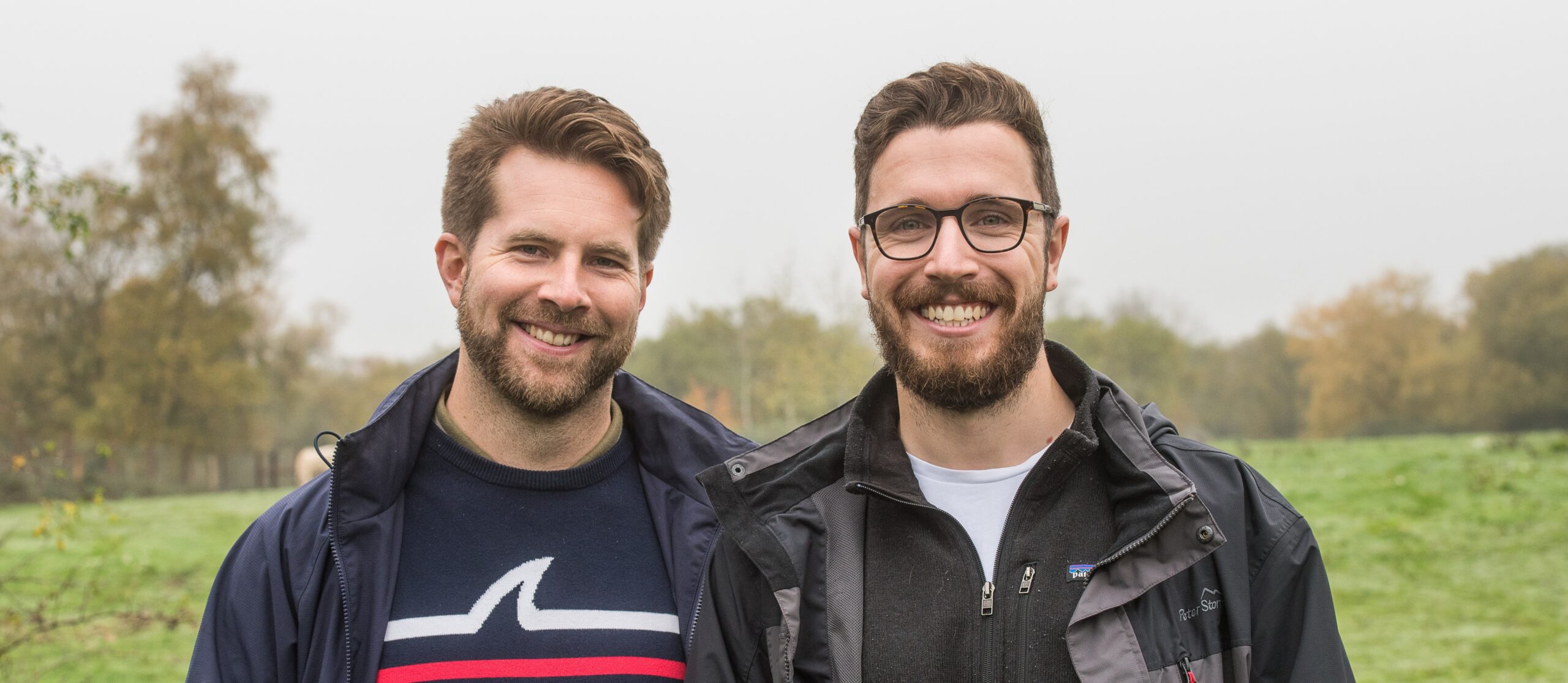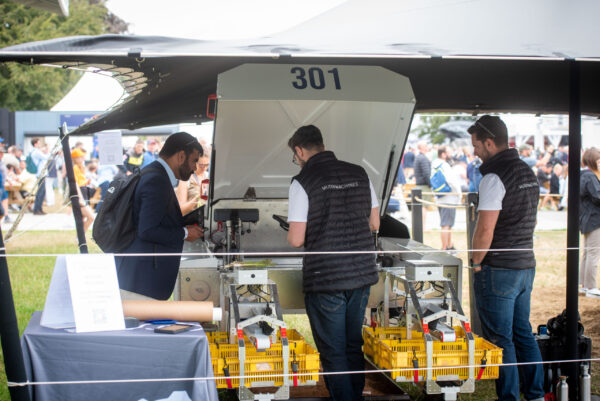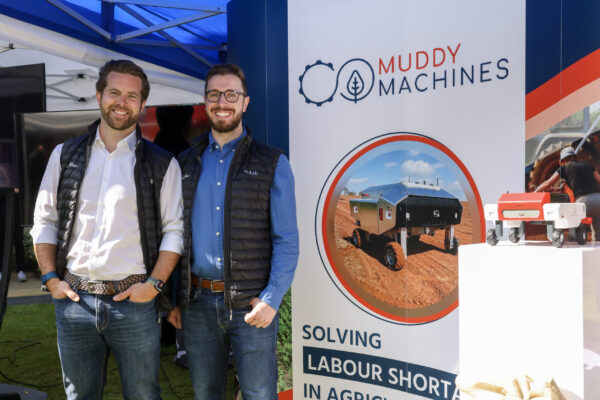Who are Muddy Machines
Q: Can you explain what Muddy Machines does?
A: Muddy Machines is a robotics company in the agriculture technology sector. Our main challenge is addressing the significant shortage of seasonal manual labor on farms. This shortage means growers often struggle with harvesting 100% of their crops because they need to be harvested daily, by hand deciding which to pick today and which to ripen for longer. This labor gap results in reduced production, increased food prices, and a higher reliance on imports.
We’ve developed a modular robotic drivetrain that can deploy various crop-specific tools. Given the diversity in crops, each requiring specific care, we’ve designed our robot to be adaptable. It’s lightweight, ensuring it doesn’t compact the soil, and it’s electrically powered, promoting sustainability. For instance, after the green asparagus harvest early in the season, we can retool the robot and deploy it for crops like broccoli or zucchini.
Currently, our team consists of 15 dedicated individuals. We’ve been in operation for three years. While growth in the hardware space isn’t as rapid as in software, we’re passionate about our mission. Working with farmers and making a difference in the agriculture sector is both rewarding and fun for us.
Q: Why did you choose to apply to Entrepreneurs First?
A: After wrapping up my previous startup, an online travel platform for holiday houses, I felt a desire to delve deeper into technology. That business was more about spotting market gaps and being quick to execute, as the technology behind it wasn’t groundbreaking. As a business graduate, I often found myself in situations where I’d identify a market need but would have to collaborate with engineers to create a solution. The technology in such ventures is often replaceable, and it’s all about being first to market.
I was drawn to Entrepreneurs First because I believed it would offer me a chance to connect with engineers, scientists, and other brilliant minds. With the right shared vision, we could create something technically challenging to replicate. While execution speed is essential, we’ve already filed two patents, indicating our commitment to creating unique solutions. The labor shortage in agriculture is a clear market gap, but it’s not one you can address with a simple smartphone app.
Entrepreneurs First’s mission resonated with me. They aim to discover talented tech individuals and offer them an escape from the corporate world. Large corporations often attract these talents with high salaries, but then these individuals might never explore entrepreneurship. Entrepreneurs First balances its cohorts with almost an equal mix of tech and business minds, which I find commendable. As a business person, I might be more common in such programs, but the blend of expertise is what makes it special.
Tips and Insights into the Application Process
Q: Can you share some insights about the application process and any advice for those considering Entrepreneurs First?
A: The application process for Entrepreneurs First is rolling, with applications opening several months in advance. After an online form, there are a few in-person interviews, though this might vary by program. Once accepted, you’re invited to join a cohort.
For preparation, it’s beneficial to familiarize yourself with the program’s culture and goals. Entrepreneurs First emphasizes the unique edge or USP of each individual. As a business person, it’s essential to articulate what makes you stand out. Entrepreneurs First is like a founder dating game, so clarity about your strengths, interests, and past achievements is crucial. This helps the interviewers gauge how you might fit into a team once the cohort begins.
An Eye into Entrepreneurs First’s Program
Once accepted, the program was initially designed to have several social events for cohort members to meet. However, due to events like COVID-19, some of these were held remotely. My advice is to study the list of cohort members diligently. If you’re a business person, focus on meeting the techies and domain experts. Understand their skills and see if there’s a match. It’s rare for two business people to team up in Entrepreneurs First, so it’s best to connect with those from different backgrounds.
The program offers extensive support, including weekly check-ins with mentors or program managers. They challenge you to test your hypotheses and ensure you’re making progress. The feedback can be direct, and teams might be advised to part ways if they aren’t progressing well. This guidance is invaluable as it comes from experienced individuals who can spot potential pitfalls.
In my journey, I formed teams with different individuals before finally partnering with Chris. These experiences taught me a lot about team dynamics and the importance of complementary skills. When we began exploring the farming problem, the positive response from farmers confirmed we were on the right track.
Q: Did Entrepreneurs First provide funding for your startup?’
A: Yes, after successfully completing the program, startups face an Investment Committee. If approved, they receive the deal they initially agreed upon. In our case, we gave 10% of our business to Entrepreneurs First, and in return, they provided £100,000. Out of this, £20,000 was deducted from program fees, leaving us with £80,000. This fund was meant to support us for another three months, leading up to a seed pitch to their network.
However, our journey was a bit atypical for Entrepreneurs First, being a hardware startup. The program seems better suited for software and SaaS ventures, where within three months, you can develop a product and gain some traction. We had to delay our pitch by six months and even then, compared to other EF companies, our progress seemed slower. We haven’t secured significant funding from the broader Entrepreneurs First network, mainly because hardware and agtech are relatively novel areas, with a stronger investor preference for software.
To gain traction in hardware, you need to invest in assets, creating a chicken-and-egg scenario. We need funding to generate revenue, but traditional investors often want to see significant revenue before funding. While SaaS ventures might demonstrate product-market fit with a million in revenues, for us, that would mean deploying robots worth around 5 million into the field to achieve such revenue in a year. It’s a challenging path, and while not unique to Entrepreneurs First, hardware startups can find it tough to align with typical VC expectations.
The Real Benefits of the Program
Q: Were there any significant realizations or “aha” moments during the program?
A: One of the most valuable insights I gained from Entrepreneurs First was the emphasis on understanding your co-founder’s personality, life situation, preferences, and goals. Investing time in truly getting to know your co-founder lays a solid foundation for the entire venture. While it might seem time-consuming, especially in a three-month program where you’re also trying to develop a business hypothesis, spending two or three days in deep conversations is invaluable. We still refer to the notes from those initial discussions even today. It’s a testament to the importance of building a strong foundational relationship in a startup.
Muddy Machines’ Journey Post Entrepreneurs First
Q: How has Muddy Machines progressed since completing the Entrepreneurs First program?
A: About a year after the program, we secured a pre-seed round, followed by a seed round last August. In total, we’ve attracted around £2 million in investments and received over £3 million in government grants. Our primary focus is on developing a commercially viable robot. By next spring, we aim to deploy several robots that can effectively replace multiple human workers. As for our funding journey, we’re currently navigating the space between Seed and Series A. We started the company during a favorable funding climate, but the environment has cooled down considerably in recent years. Like many startups, we’ve had to adjust our expectations and timelines for raising capital, ensuring our resources last as we work towards our next milestones.
Final Advice
Q: Any advice for founders considering applying to Entrepreneurs First?
A: It’s crucial to understand what you’re seeking from the program. If you already have a business idea and a co-founder with the skills you need, then the program might not be necessary for you. Giving up 10% of your company is a significant commitment, especially if Entrepreneurs First isn’t providing the recruitment aspect for you. For me, the value was clear: I needed access to top-tier engineering talent. Finding an exceptional tech individual who’s left their job, is eager to embark on an entrepreneurial journey, and is searching for the right co-founder is rare. Entrepreneurs First creates that unique environment where such connections can happen. If that’s what you’re looking for, then the program is invaluable. Otherwise, weigh the costs and benefits carefully.



